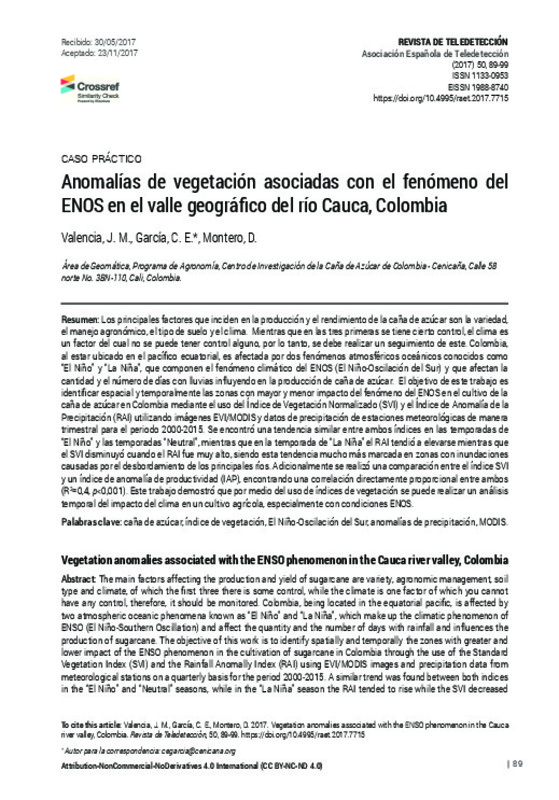|
Resumen:
|
[EN] The main factors affecting the production and yield of sugarcane are variety, agronomic management, soil type and climate, of which the first three there is some control, while the climate is one factor of which you ...[+]
[EN] The main factors affecting the production and yield of sugarcane are variety, agronomic management, soil type and climate, of which the first three there is some control, while the climate is one factor of which you cannot have any control, therefore, it should be monitored. Colombia, being located in the equatorial pacific, is affected by two atmospheric oceanic phenomena known as “El Niño” and “La Niña”, which make up the climatic phenomenon of ENSO (El Niño-Southern Oscillation) and affect the quantity and the number of days with rainfall and influences the production of sugarcane. The objective of this work is to identify spatially and temporally the zones with greater and lower impact of the ENSO phenomenon in the cultivation of sugarcane in Colombia through the use of the Standard Vegetation Index (SVI) and the Rainfall Anomally Index (RAI) using EVI/MODIS images and precipitation data from meteorological stations on a quarterly basis for the period 2000-2015. A similar trend was found between both indices in the “El Niño” and “Neutral” seasons, while in the “La Niña” season the RAI tended to rise while the SVI decreased when the RAI was very high, this tendency being much more marked in areas with floods caused by the overflow of the main rivers. In addition, a comparison was made between the SVI index and a productivity anomaly index (IAP), finding a direct correlation between both (R2 = 0.4, p<0.001). This work showed that through the use of vegetation indexes, a temporal analysis of the impact of climate on an agricultural crop can be carried out, especially with ENSO conditions.
[-]
[ES] Los principales factores que inciden en la producción y el rendimiento de la caña de azúcar son la variedad, el manejo agronómico, el tipo de suelo y el clima. Mientras que en las tres primeras se tiene cierto control, ...[+]
[ES] Los principales factores que inciden en la producción y el rendimiento de la caña de azúcar son la variedad, el manejo agronómico, el tipo de suelo y el clima. Mientras que en las tres primeras se tiene cierto control, el clima es un factor del cual no se puede tener control alguno, por lo tanto, se debe realizar un seguimiento de este. Colombia, al estar ubicado en el pacífico ecuatorial, es afectada por dos fenómenos atmosféricos oceánicos conocidos como “El Niño” y “La Niña”, que componen el fenómeno climático del ENOS (El Niño-Oscilación del Sur) y que afectan la cantidad y el número de días con lluvias influyendo en la producción de caña de azúcar. El objetivo de este trabajo es identificar espacial y temporalmente las zonas con mayor y menor impacto del fenómeno del ENOS en el cultivo de la caña de azúcar en Colombia mediante el uso del Índice de Vegetación Normalizado (SVI) y el Índice de Anomalía de la Precipitación (RAI) utilizando imágenes EVI/MODIS y datos de precipitación de estaciones meteorológicas de manera trimestral para el periodo 2000-2015. Se encontró una tendencia similar entre ambos índices en las temporadas de “El Niño” y las temporadas “Neutral”, mientras que en la temporada de “La Niña” el RAI tendió a elevarse mientras que el SVI disminuyó cuando el RAI fue muy alto, siendo esta tendencia mucho más marcada en zonas con inundaciones causadas por el desbordamiento de los principales ríos. Adicionalmente se realizó una comparación entre el índice SVI y un índice de anomalía de productividad (IAP), encontrando una correlación directamente proporcional entre ambos (R2 = 0,4, p<0,001). Este trabajo demostró que por medio del uso de índices de vegetación se puede realizar un análisis temporal del impacto del clima en un cultivo agrícola, especialmente con condiciones ENOS.
[-]
|








